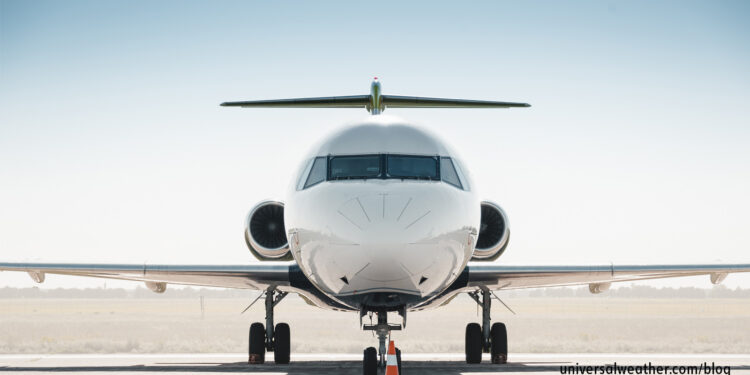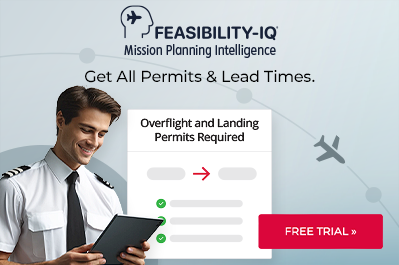Top 10 Business Aviation Planning Tips for Australia (+1 More)

This is a post by author Tony King. Tony is the general manager at Universal Aviation Australia, which aircraft ground handling facilities in Sydney and Perth. Tony is an expert on business aircraft operations in Australia and can be contacted at tonyking@universalaviation.aero.
For business aircraft operators traveling to Australia, there are some unique requirements – ranging from flight planning, to fueling, to visas and more – that must be considered before operating into the region. Below we have compiled 11 planning tips – our “Top 10, plus 1” – for operating into Australia:
1. Be aware of Transportation Security Program requirements
Based on regulatory changes, and effective March 2012, private non-revenue flights with principals/owners onboard may not require a Transportation Security Program (TSP) if they are not completing more than four Australian flights within a 12-month period. The following do require an approved TSP:
- all charter (non-scheduled commercial) flights
- all private non-revenue flights beyond four per year
- cargo flights
- aircraft coming to Australia for demonstration and/or sales purposes
It can take up to 60 days to apply for and obtain a TSP, and penalties for non-compliance are fines of up to AUD$22,000. Further important information can be found at the Australian Government Department of Infrastructure and Regional Development website. Additionally, your local ground handler can assist with this application process.
2. Charter flights, and some private non-revenue flights, require landing permits
All charter operations need charter permission from the Civil Aviation Safety Authority (CASA), and the official lead time is in excess of five working days. Private non-revenue operators may require specific permission based on the noise status of the aircraft, passenger loads, and frequency of operations to Australia. If operating an International Civil Aviation Organization (ICAO) Stage 3 aircraft with a hush kit, you will need a Department of Transport & Environment (DTE) permit, which takes approximately five working days. The DTE permit is required when operating to Sydney (YSSY), Melbourne (YMML), Perth (YPPH), Adelaide (YPAD), Hobart (YMHB), Canberra (YSCB), Darwin (YPDN), Gold Coast (YBCG), Newcastle (YWLM), Essendon (YMEN), and Avalon (YMAV). If you are a frequent private operator to Australia (4-5 times per year) with high passenger loads (typically 20 or more), DTE may want you to have a permit, which takes approximately 10 working days to obtain. Overflight permits for either charter or private non-revenue flights are not required for Australia. ICAO Stage 2 aircraft are not permitted to operate in Australia. Please note that Stage 2 aircraft which have been made compliant with Chapter 3 hush kits are acceptable but are considered “marginally compliant” or “MCC3” if they have an operating weight in excess of 34,000 kg (66100 lbs.). Such aircraft are restricted from operations at major airports. If you are unsure about the Noise Category of your aircraft, it is best to refer the details of your operation to your 3rd-party provider, ground handler, or Airservices Australia.
3. Know airport slot requirements and limitations
YSSY and YPPH are the only airports in Australia requiring airport slots for both arrivals and departures. YBBN mandates arrival slots but not departure slots, and only in the case when the previous departure point is within 160 nautical miles (NM) of YBBN. This assists YBBN airport authorities in managing airport traffic. Airport slots may be required at other locations in Australia, but only when large local events are in progress. Airport slots have a tolerance deviation of -/+ 30 minutes for sector times in excess of three hours, and -/+15 minutes for sector times of less than three hours. Operators should also be mindful of slot availability issues during peak periods, particularly in YSSY and Brisbane (YBBN), where high volumes of commercial traffic are regularly experienced. You should consult with your 3rd-party provider or ground handler if you have any concerns about your proposed itinerary.
4. Certain aircraft equipment is needed to operate to Australia
Automatic dependent surveillance-broadcast (ADS-B) (effective on December 12, 2013), Traffic Collision Avoidance System (TCAS) II, Reduced Vertical Separation Minima (RVSM), certification, and Minimum Navigation Performance Specifications (MNPS) are all required in Australia, in certain airspace and under certain conditions. Operators may, however, apply for waivers and exemptions to operate without required equipment/certifications, provided they meet certain criteria. Waivers normally require seven working days’ notice (with the exception that ADS-B requires 14 days’ notice) and may impact your desired flight routing. Once a waiver is obtained, your 3rd-party provider will plan flight routings to avoid restricted airspace.
5. Be aware of operating curfews
YSSY and YPAD have 23:00-06:00 (local time) curfews and restrict certain aircraft from operating during these times. Approved aircraft must not have a takeoff weight greater than 34,000 kg (66100 lbs.) at their departure point, which may entail an additional tech stop. Prop-jets are permitted to operate during curfew hours, together with corporate aircraft on exempted lists. For YPAD, exempted aircraft may operate normally during curfew hours. At YSSY, aircraft may only use one runway, and only arriving from the south and departing to the south, during curfew hours to avoid flying over the city. Please be aware that any breach of curfew hours or restrictions will result in extremely heavy fines.
6. Know fuel and 4th-party vendor considerations
Fuel suppliers throughout Australia accept major credit and aviation fuel cards, as well as fuel releases. Operators should try to always provide as much advance, and accurate, notice as possible for fuel uplifts. Due to commercial airline commitments, General Aviation (GA) fueling delays may be as long as two hours at some major airports. Credit is possible for all 4th-party services with arrangements made in advance.
7. Airside/plane-side pick-up/drop may be possible
Private vehicles are allowed on airport ramps in Australia provided appropriate authorization and airside passes can be arranged beforehand. Ground handlers can assist with the necessary paperwork and passes. It is generally not a problem having a vehicle pick you up plane-side when operating domestically or in the case of international arrivals when customs clearance is accomplished onboard. If arriving at YSSY where customs is cleared in the Fixed Base Operator (FBO), plane-side local transport pick up is not a viable option.
8. Know day-of-operation flight planning process
Flight plans may be filed up to 24 hours in advance but must be submitted a minimum of one hour prior to departure. As long as a departure airport slot has been arranged prior, you will be able to depart at the time requested.
9. Aircraft cabin must be spray-disinsected prior to international arrival
An approved disinsectant spray should be used in the cabin at top of descent. Upon landing, biosecurity agents from the Department of Agriculture, Farming, and Fisheries will want to see the empty spray can and will ask the captain to sign a form confirming that cabin has been sprayed. If you do not have appropriate disinsectant, your cabin will be sprayed by customs on landing. If this happens, doors must remain closed with passengers onboard for 10 minutes.
10. ADS-B requirements in Australia
Effective December 12, 2013, aircraft flying at or above Flight Level (FL) 290 are required to be fitted with ADS-B equipment. ADS-B restrictions will apply from the territorial boundary (12 nautical miles) around continental Australia, but it will not be required over Oceanic airspace. All non-ADS-B-equipped aircraft will be forced to enter Australian airspace at lower flight levels. Exemptions are available with two weeks prior notification, remaining valid until December 11, 2015, and will only apply to the eastern coast area under radar coverage.
Pacific traffic will not be affected, but north and northwestern traffic (e.g., Asian departures) will be held to FL290 or below.
For more information on ADS-B in Australia, please see our article titled “Upcoming ADS-B Requirements in Australian Airspace” or visit the Australian Government ComLaw website.
11. Visa requirements for Australia
Visas are required when traveling to Australia. Specifically, all passengers must have a valid visa prior to entering the country. Without this visa, there may be a considerable fine for breaching this regulation, or in the worst case the passenger(s) will not be permitted into the country. Crews also require a visa for Australia. Depending on the nationality, crew may be able to apply for it online, and it’s referred to as the “Crew Travel Authority (CTA).” The CTA may be obtained through the Advance Passenger Professing (APP) website. Alternatively, you may request it via email at appwebsite@immi.gov.au. For more information, please speak to your 3rd-party provider or ground handler.
Closing thoughts
When operating into Australia, it is best to work with your 3rd-party provider to review required permits, routing instructions, customs and immigration requirements, and operating curfew considerations well before your anticipated flight.
Questions?
If you have any questions about this article or need assistance with business aircraft operations in Australia, contact me at christinevamvakas@universalaviation.aero.




